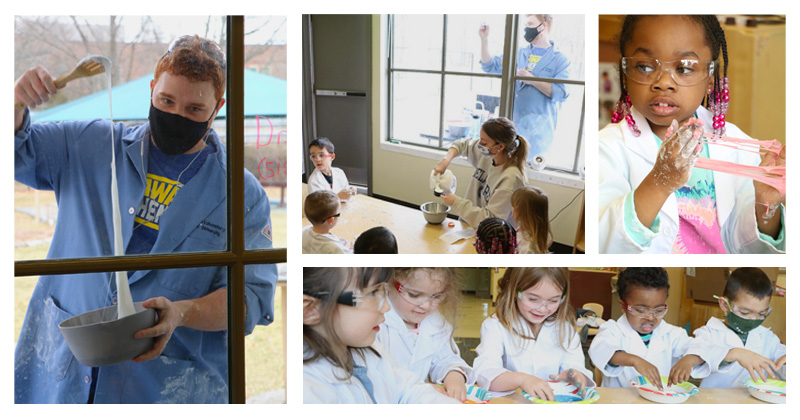Window Science

How a UD professor brought science projects back to preschool
When children are learning, things can sometimes get a little messy.
Like on a sunny spring morning in the preschool classrooms at the Early Learning Center, located on the University of Delaware’s Children’s Campus, when groups of children aged four and five gathered around metal bowls to practice mixing recipes, a common method of teaching science and math in preschool.
The children were very excited about the next recipe:
- ½ teaspoon baking soda
- ¼ cup water
- ⅔ cup of Elmer’s glue
- 2-3 cups of foam shaving cream
- 1.5 tablespoons of contact solution
- Food coloring of choice.
The children, dressed in lab coats and safety goggles, followed the steps and mixed the ingredients together in the large bowl, with a little help from the teacher, to create a thick foamy slime.
“I feel like my brain is super, super happy,” said Keegan, a young child.
His friend Ahmet replied, “I feel like my brain is going to explode!”
Shrills of childish glee at another table suggested the students over there had just finished their batch of gooey slime.
“This feels like duck legs,” said Darla, holding a firm, solid putty.
As the children and their teachers mixed their slime, on the other side of the window, standing outside in the fresh spring air, Tyler Van Buren, a UD mechanical engineering assistant professor, spoke through a microphone and guided the class through the experiments, using the large classroom windows as a whiteboard.
Van Buren calls it “Window Science,” and it’s a safe yet fun way for scientists to collaborate on learning activities with learning facilities while minimizing the likelihood of spreading the coronavirus.
Van Buren wanted the children to play with slimes because mixing a recipe requires learning some basic math — like measuring, counting and following directions — but also because slimes challenge tidy scientific notions like the stages of matter. The slimes these children created are called “polymers,” which have characteristics of solids and liquids.
“Children grow up learning that things are either solid, liquid or gas, and then there are things that can behave like one or another, depending on the situation, and slimes are a good example of that,” said Van Buren. “Plus they’re just fun to play with.”
Van Buren provided the supplies and coordinated with teachers at the Early Learning Center to ensure that everything was in place for the science project to be a success.
“Children learn in a variety of ways, and experiencing a hands-on program helps their learning goals,” said Jessica Peace, associate director for Preschool and School Age Children at the Early Learning Center, adding that having multiple slime recipes allowed all the children involved on an individual level. “It was COVID-friendly, and it met the sensory needs of our children.”
Van Buren is one of many UD scientists and faculty who have partnered with the Early Learning Center in recent years to bring unique learning activities to children. In addition to science and engineering, the Early Learning Center has developed learning activities with faculty in music, art, physical therapy and beyond, including an outdoor edible forest garden with the College of Agriculture. However, when the Early Learning Center resumed operations in June 2020, coronavirus safety protocols limited who would be allowed access to rooms with young children.
Building partnerships with experts throughout the University community was a point of pride for the Early Learning Center. Now, that same level of collaboration could endanger children, many who are too young to reliably wear a mask and keep their hands away from their faces.
The problem confounded Van Buren. How could the children continue to have engaging learning experiences with the broader UD community without sacrificing safety?
After developing the program at home with his daughter, and learning how to write backward on a window so his notes are legible to those inside, Van Buren arrived at Window Science, or using windows as a learning tool to share knowledge with children inside a secure environment.
“Attaching excitement to science is the best thing to do with that age group because they will always remember that science is exciting, and then they’ll be more interested in learning about it,” said Van Buren. “Seeing their excitement reinvigorates my own passion for science.”
Article by Jordan Howell. Photos by Jessica Peace.



